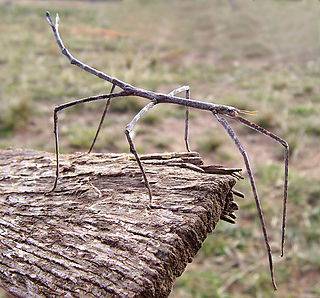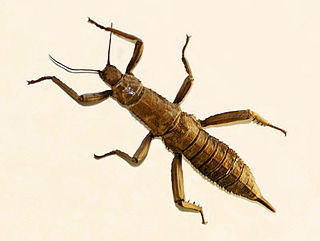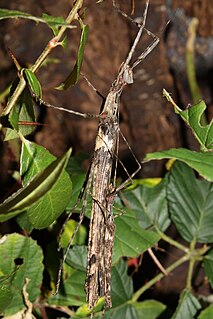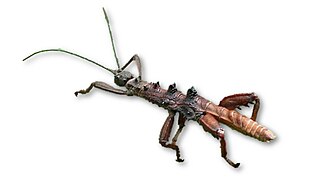
The Phasmatodea are an order of insects whose members are variously known as stick insects, stick-bugs, walking sticks, stick animals, or bug sticks. They are generally referred to as phasmatodeans, phasmids, or ghost insects. Phasmids in the family Phylliidae are called leaf insects, leaf-bugs, walking leaves, or bug leaves. The group's name is derived from the Ancient Greek φάσμα phasma, meaning an apparition or phantom, referring to their resemblance to vegetation while in fact being animals. Their natural camouflage makes them difficult for predators to detect; still, many species have one of several secondary lines of defense in the form of startle displays, spines or toxic secretions. Stick insects from the genera Phryganistria, Ctenomorpha, and Phobaeticus include the world's longest insects.

Extatosoma is a genus of phasmids, in the monotypic subfamily Extatosomatinae, with two species. One occurs in Australia, one in New Guinea. Both have a colour morph imitating leaves, and one imitating lichen.

Carausius is a genus of the tribe Lonchodini, in the order Phasmatodea. The genus is in many ways typical of the Phasmatodea in that all species are twig-like in appearance. These species are parthenogenetic.

Agathemera is a genus of stick insects in the suborder Euphasmatodea and superfamily Pseudophasmatoidea. It consists of several species limited to the mountainous regions of Argentina, Bolivia, Chile and Peru.

The Euphasmatodea, also known by its junior synonym Verophasmatodea is a suborder of the Phasmatodea, which contains the vast majority of the extant species of stick and leaf insects.

The Phasmatinae are a subfamily of stick insects in the family Phasmatidae. They contain at least three tribes; Bradley and Galil corrected the spelling to "Phasmatinae" and provides a key to tribes.

Necrosciinae is a subfamily of the stick insect family Lonchodidae, with its greatest diversity in South-East Asia.

Eurycantha is a genus of stick insects belonging to the family Phasmatidae. It was described by Jean Baptiste Boisduval in 1835.
Charmides cerberus, is a species of phasmid or stick insect of the monotypic genus Charmides. It is endemic to Sri Lanka.
Nanophyllium brevipenne, is a species of phasmid or leaf insect of the genus Nanophyllium. It is found in New Guinea, and Sri Lanka.
Pseudomicrophyllium geryon is a species of phasmid or leaf insect. It is found in the Philippines, Java (Indonesia), and Sri Lanka.

Trachythorax is an Asian genus of stick insects in the family Lonchodidae and subfamily Necrosciinae. Species have been recorded from the Indian subcontinent, Indo-China, Malesia through to New Guinea.

Pachymorphinae is a subfamily of stick insects in the family Phasmatidae. Genera are primarily found in Africa, Asia and Australia.

The Clitumninae are a sub-family of stick insects in the family Phasmatidae found in Asia. The type genus Clitumnus is now considered a synonym of Ramulus.
Lobofemora is a genus of stick insects in the subfamily Clitumninae. Species have known distributions from National Parks in Vietnam.
Lobofemora scheirei is a species of stick insects in the tribe Clitumnini. This species was found in the seasonal tropical forests of the Dong Nai Biosphere Reserve, which includes Cát Tiên National Park, Vietnam. It is named after the Belgian comedian, TV host and self-declared nerd Lieven Scheire.

The Platycraninae are an anareolate subfamily of stick insects in the family Phasmatidae. Their known distribution includes southern, southeast Asia and Australasia.

The Megacraniinae are an anareolate subfamily of stick insects in the family Phasmatidae. Their known distribution includes Malesia and islands in the Pacific and Indian oceans. Several genera have been revised and were placed previously in the Platycraninae.

Platycrana is the type genus of the reconstituted subfamily Platycraninae: which are stick insects from the Asia-Pacific region. They belong to the monotypic tribe PlatycraniniBrunner von Wattenwyl, 1893. There is a monotypic species: Platycrana viridana(Olivier, 1792): originally described as "Mantis viridana" Olivier AG, with the type locality in the Moluccas.

Theramenes is an Asian genus of stick insects in the tribe Obrimini. Species have been recorded from the Philippine and Talaud Islands.















